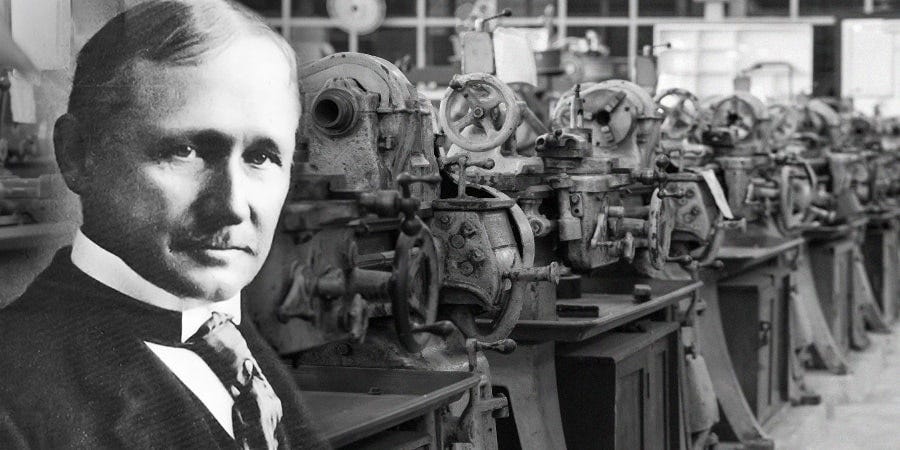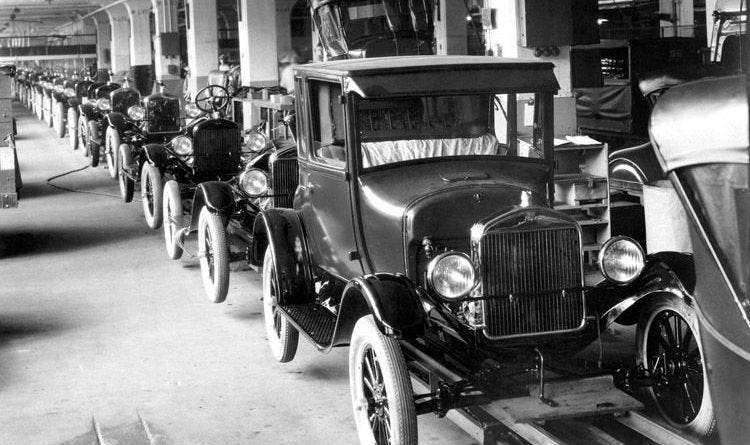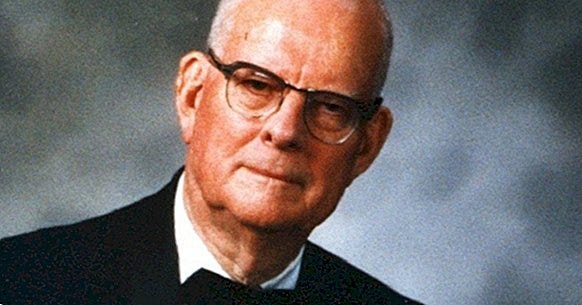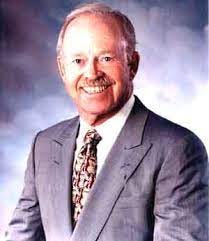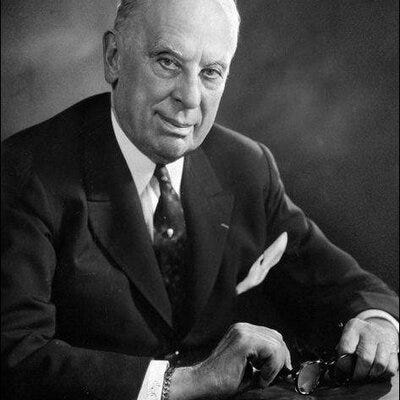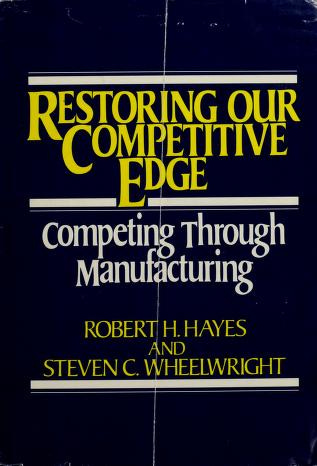The evolution and influence of thinking in management Part 2: Production Management
An unpublished series of management ideas
The second part covers ideas and practices which have shaped the way we think about manufacturing today.
Production Thought
At the turn of the 20th Century, the business community was primarily concerned with manufacturing and assembly. There were no guide books or management manuals to assist managers at the time and management thought had been guided by historical antidote. Frederick Taylor was an engineer who carried out time and motion experiments on the workforce at the two steel mills he worked at. Taylor came up with a set of principals in what became known as scientific management. Taylor believed that the principal objective of management was to secure the maximum output per worker[i], taking all thinking away from the shopfloor. He laid down a set of guidelines[ii] for managers to determine the single best way of doing things, eliminating all useless movements. Workers would be set targets and quotas with incentives and penalties. Management would walk around the shopfloor timing workers performance and measuring it against standards. Management would be able to find the best person to perform each action, thus leading to optimum efficiency.
Frederick Taylor
The concept of scientific management sweep through corporate America. It was seen as a solution to poor worker motivation, which was considered a major problem at the time. Scientific management had its critics then and now, been seen as dehumanising. It was also criticised for focusing on quantity and ignoring quality. However, scientific management was the first set of management principals that could be put into effect by managers at the time. In fact, there are still thousands upon thousands of factories around the world today that utilise this philosophy, without managers even knowing it is scientific management. Ninety years later elements of Taylor’s principals have re-emerged in Champy and Hammer’s concept of re-engineering.
Taylor also advocated automating as much as the workflow as possible in what became the beginnings of mass production. This was achieved through specialisation and division of labour. Henry Ford utilised these principals and built a mass production line with workers performing specific set tasks. Ford focused on developing standardisation of production, utilising uniform parts to produce automobiles at the minimum possible cost, so that cars could be marketed to the masses. This was in stark contrast to other automobile production at the time which produced made for order based on teams of skilled craftsmen.
The company organisation developed into specialised separated departments fulfilling the functions of the company like purchasing, production, sales, accounting, personnel and R&D without lateral communication between the departments. Managers had their specialised functions and were encouraged to focus on their responsibilities and not worry about problems in other departments.
Henry Ford was able to create a large functional organisation that could produce products at a cost which enabled marketing to the general population. Ford’s orientation was to set a price and then expect the company to develop production in a way where cost could meet his price objectives[iii]. This set the tide rolling towards the industrial era in the US, where large corporations dominated the economy for many decades. However Ford’s organisation was not without it’s problems. Mass production lacked flexibility which customers could take advantage of, which at a time the Ford Motor Company nearly succumbed to. The nature of mass production created worker alienation, which manifested itself in the growth of labour unions and the nature of organisation utilised by Ford created sub-cultures which tended to see other departments in the same organisation as foes and adversaries, leading to an absence of teamwork, a problem many corporations still suffer from.
While America’s industrial sector became a world leader, after World War II, the Japanese economy was almost completely devastated. Japanese industrialists turned to W. Edwards Deming and Joseph Juran, who at the time were almost totally ignored in their own country. Deming advocated that meeting customer expectations through quality was the key goal of the organisation and products should be totally redesigned along with production layouts, so that quality could become part of the process, rather than an inspection after the product is produced. The pursuit of quality holistically by an organisation would create total commitment. Deming’s system relied on producing statistical information which would be used by groups on the shopfloor with management to create a process of continual improvement in the organisation[iv]. Juran’s ideas were similar and focused on developing the whole organisation as a systematic process to seek continual quality improvement, where quality was the responsibility of each and every employee. Juran developed a concept called Company-Wide Quality Management (CWQM)[v].
W. Edwards Deming
Deming and Juran’s systems fitted well into the collective culture of Japanese society and managed to link customer orientation into the production floor where workers were empowered to control the process under a system called Total Quality Management (TQM). Quality was redefined as a process and not a standard. The success of the Japanese economy and rise of Japanese brands in the 1980’s helped to bring on a management romance with Japanese techniques, however even though numerous consultants and books appeared, Western companies had many problems in totally accepting and implementing the quality concepts espoused.
In the early 80’s quality began to be considered a key to organisational effectiveness and customer responsiveness, particularly with the superior quality of Japanese manufactured goods in the market. A number of gurus began preaching the value of enterprise quality around the world. Philip Crosby argued to corporate America that quality lies in simplicity and firms should seek excellence and develop a culture of continuous improvement in all aspects of the business, including customer relations and all employees should be involved. Crosby asserted that quality is free and in his book of the same name said the road to quality will result in cost reductions, higher profits and turn the organisation into one that is customer orientated[vi]. David Hutchins in Europe developed quality circles alone similar philosophies[vii] and many businesses and Government organisations (including Malaysia) employed consultants and attempted to implement these new ideas. By the end of the 1980’s most organisations became disillusioned with the concept probably because of insufficient management support at the top, as it was seen to interfere with management prerogatives. However the quality movement put more people orientation into the management of the workplace through watered down programs with similar objectives.
Philip Crosby
The ‘quality movement’ manifested itself with a number of ‘branded derivatives’ ; Quality Management Systems, Performance Measurement, ’Excellence Model’, TQM Self Assessment and the latest hybrid The Six Sigma. This fascination with Japanese management techniques, the ideas of kaizen (continuous improvement) and Porter’s concept of competitive advantage, gave rise to the idea of determining who is the very best and measuring one’s own processes against that benchmark. It is a continuous systematic process for evaluating products, services or flows and processes against the identified competitive standard. McNair and Liebfried outlined four areas where benchmarking can be applied[viii];
1. Internal Benchmarking is a process similar to quality management, where the company’s standards are checked to see if there can be further improvements in quality and cuts in wastage,
2. Competitive Benchmarking to compare the company’s standards against rival companies in the marketplace,
3. Industry Benchmarking to compare the company’s standards against the general industry, and
4. Best-in-Class Benchmarking to compare the company’s standards against the best companies in the world.
Measures of corporate performance had been mainly financially based and benchmarking took a wider company measure over processes, customer service, products and other potential key measures. Benchmarking was initially utilized for manufacturing processes, but Xerox in the 1980’s used to method to compare themselves to their competitors products and customer service, so they could learn how to outperform their rivals.
Benchmarking was originally used by Xerox in the US, when it lost dramatic marketshare in the mid 1980’s. Benchmarking became very popular in the United States, Japan and Europe, particularly with large corporations. It is usually utilized with another program like lean manufacturing or re-engineering. Benchmarking can be a powerful management tool for change and also seeking ways to develop competitive advantage over rivals in the market. The tool helps highlight to employees what needs to be done in the firm to survive in the long term, thus helping to show the realities of the environment the firm is facing, forcing problems to be solved.
As corporate America continued to rise in the first half of the 20th Century, the sheer size of many organisations began to show lack of responsiveness to their customers due to cumbersome bureaucracies. This required an overhaul of the functional bureaucracies controlling manufacturing ventures into something more effective. Alfred P. Sloan of General Motors was faced with this problem during the crash of the 1930’s and in competition with Ford. Sloan re-organised General Motors along federal (state) and product lines with decentralised decision making authority in regards to all respects of their operations[ix].
Alfred P. Sloan
Decentralisation was not a new idea. The East India Company operated decentrally[x] in the 1700’s due to very slow communications at that time. This was however due to necessity, rather than an act of strategy. Decentralisation allowed managers to vary strategies, organisational design and control systems to suit their particular markets and thus be more responsive to their customers. Sloan’s decentralisation showed that organisations need to be modelled on the particular strategy the firm wishes to follow and in the case of a large company serving multiple geographical markets, multiple strategies may need to be followed, which Chandler expanded upon in strategic management theory[xi]. Corporate decentralisation became the model that was followed for decades by large corporate organisations and was utilised by most multi-national corporations around the world to balance central with regional control[xii].
In the late 80’s and 90’s, decentralisation began to show weaknesses as it was inflexible and cumbersome to operate within. These corporate empires became the field of conquest by strong divisions like finance that wrapped other divisions in paperwork and procedure, creating powerful divisions exercising lateral control through internal power strategies.
In the 1980’s manufacturing became the US concern again for management. Japanese and European goods were flooding the US market and US industry was feared to lose it’s dominance. Hayes and Wheelwright published a manifesto warning US manufacturers that if the manufacturing sector continues to be neglected by management, it will not survive. Hayes and Wheelwright argued that the tight financial controls exercised by corporations over their manufacturing operations leads to lack of innovation and failure to look at the long term implications of their decisions[xiii]. They further argued that manufacturing is viewed as having a neutral role in the company’s overall corporate strategy and with technology aggressiveness, the role of manufacturing could be turned into a source of company competitive advantage. Manufacturing should be seen as a productive confederation with strong linkages to the rest of the corporation, customers, competitors, suppliers and machinery manufacturers. From the strategic point of view capacity, facilities (including location), process technology and the product/process matrix should be examined to develop the best overall configuration to suit the long term strategic objectives of the company. This should be an evolutionary process where decisions about vertical integration and ‘make or buy’ can evolve over a period of time, thereby improving on competitive advantage. Hayes and Wheelwrights ideas did influence the approaches to manufacturing, supply chain management and overall strategic development of companies and brought attention to the complexity of manufacturing and strategy to the management of corporations during the 80’s and 90’s. It did not reach the limelight of many other ideas as Hayes and Wheelwright did not offer the ‘quick fixes’ that some other ideas were offering at the time.
The Japanese manufacturing phenomenon continued to infatuate western management during the 1980’s with many authors publishing explanations of the Japanese success and reasons for US failure to keep up with the new competition. Lean production was developed from a combination of Japanese manufacturing and process techniques based on three tenants. Firstly the shopfloor was based on just-in-time assembly, where suppliers would deliver to the shopfloor at the time parts were needed for the assembly of a product that was to meet customer requirements at a specific time. This was appealing because the just-in-time philosophy aimed to eliminate all inventory on the part of the manufacturer, thus saving investment in parts waiting around for use on the assembly line. This was in stark contrast to minimum re-order point purchasing and materials requirement planning (MRP) used in the US which required the holding of large stocks on inventory. Secondly, responsibility for quality rested with all employees of the organisation and the quality assurance aspect of the production process was integrated into the line with immediate corrections, rather than inspections where defects were put aside for rework after assembly. The term ‘zero defects’ became the catch cry. Thirdly, was the development of a value system which promoted the company as an integrated organisation dedicated to serving the customer through quality, coupled in close relationships with both suppliers and customers.
Richard Schonberger summarised all these concepts and processes[xiv] in 1982, six years before Monden Yosuhsiro and Ohno Taichi espoused the Toyota Manufacturing System which was based on lean production in 1988. In 1990, Womack, Jones and Roos from MIT and Cardiff Business School hypothesised that the US was still in the age of mass production, while the Japanese had been able to combine the flexibility of craftsmen with the cost savings of mass production[xv]. Thus, if teams are reorganised into production teams, both the quality of the craftsman and low costs of mass production could be achieved. Womack, Jones and Roos were certainly not new in their ideas, but their book became a bestseller and seen by many in the corporate world as a ‘quick fix’. Most of their ideas were misinterpreted as managers saw lean production as a means to cut back on staff and declare themselves a lean organisation.
Besides misinterpretation, lean production was modelled around the automobile industry and it proved very difficult to translate the ideas to other industries, except engineering based assembly industries. However some of these companies like British Aerospace derived great benefits from this philosophy.
Michael Hammer published an article in the Harvard Business Review in 1990 proposing a rethinking and complete redesign of the businesses processes to achieve radical improvements in performance, cost, quality, service and speed[xvi]. Hammer in 1993 expanded upon this philosophy 1993 with James Champy publishing a bestseller advocating the complete analysis of all business processes in a company and redesigning them in the most efficient way possible to eliminate all wastage. Companies develop set ways of doing things which have usually developed into inefficient silos, hindering company performance. This method was referred to as Business Process Re-engineering (BPR)[xvii].
James Champy
Many critics saw re-engineering as a return to the days of Taylorism and Scientific Management, while others criticised it as a lean excuse for redundancies, which were being forced upon many corporations due to the advent of information technology that was reducing the need for employees. One of the greatest problems with the philosophy was that executives were only too willing to cut down aspects of the organisation that didn’t personally affect them, but were loathed to do anything that would affect their own livelihoods and as Hammer himself said executives were the ones themselves that undermined the the very structure of their rebuilt enterprises[xviii]. Re-engineering became another management catch cry bringing in large revenues for CSC Management Consultancy, which James Champy was principal. Companies like Hallmark Cards and Kodak in the US successfully applied re-engineering with very positive results, but BPR became so much associated with redundancies, it forced a change of name to Business Process Improvement (BPI).
Click on subscribe so articles can be directly emailed to your inbox:
References:
[i] Taylor, F.W., (1903) Shop Management, New York, Harper & Row.
[ii] Taylor, F.W. (1913) The Principals of Scientific Management, New York, Harper & Row.
[iii] Ford, H., (1923), My Life and Work, New York, Page & Co.
[iv] Deming, W. E., (1982) Quality, Productivity and Competitive Position, Mass., MIT Centre for Advanced Engineering Study, MIT.
[v] Juran, J., (1988) Juran on Planning for Quality, New York, Free Press.
[vi] Crosby, P., (1979) Quality is Free, New York, McGraw-Hill.
[vii] Hutchins, D. (1985) Quality Circles Handbook, London, Pitman.
[viii] Mcnair, C., J., and Liebfried, H., J., (1992), Benchmarking: A tool for continuous improvement, New York, John Wiley.
[ix] Sloan, A., P., (1963), My Years with General Motors, New York, Doubleday.
[x] Hindle, T., (2000), Guide to Management Ideas, London, Profile Books
[xi] Chandler, A. D., (1962) Strategy and Structure, Boston, MIT Press.
[xii] Ghertman, M. and Allen, M., (1984), An Introduction to the Multinationals, London, The MacMillan Press.
[xiii] Hayes, R. H. and Wheelwright, S. C., (1984), Restoring Our Competitive Edge: Competing Through Manufacturing, New York, John Wiley & Sons.
[xiv] Schonberger, R. J. (1982), Japanese Manufacturing Techniques: Nine Hidden Lessons in Simplicity, New York, Free Press.
[xv] Womack, J., Jones, D. T. and Roos, D., (1990), The Machine That Changed The World, London, Macmillan.
[xvi] Hammer, M., (1990), ‘Re-engineering Work: Don’t Automate, Obliterate’, Harvard Business Review, July-August.
[xvii] Champy, J. and Hammer, M., (1993) Re-engineering the Corporation, New York, Harper Business.
[xviii] Champy, J., (1995) Re-engineering Management: the Mandate for New Leadership, New York, Harper Business.





